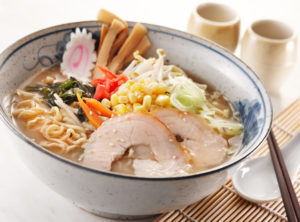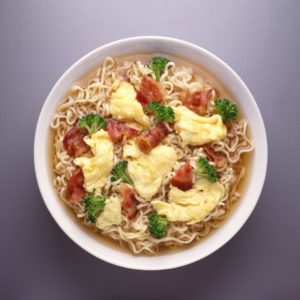In August 2014, The Washington Post reported that the popularity of ramen had peaked in Japan, with the noodle soup becoming so common that restaurants were running out of inspiration for intriguing variations. That point of market saturation still seems far off in the U.S., where enthusiasm for the dish remains unabated and new noodle shops continue to open. Those attending international culinary schools will benefit from learning about ramen, a phenomenon available in nearly endless varieties, and the forms it has taken in American restaurants.
The basics of ramen
Though it has been ubiquitous in Japan for many years now, ramen originated in China. According to New York University historian George Solt, the soup with long, stretchable noodles likely first came to Japan in 1910, when a customs agent founded a Tokyo restaurant. Though ramen largely disappeared due to strict food regulations during World War II, it roared back into popularity in the economic boom of the 1950s.
While the variations on ramen ingredients and flavors from different regions of Japan and individual shops are seemingly inexhaustible, soups are often identified by broth. Four types frequently appear in U.S. restaurants. Shoyu, based in soy sauce, is the most common broth in Tokyo. The popular tonkotsu is exceptionally heavy and made with slow-cooked pork bones. The light shio is made with dried seafood and seaweed. Miso broth is flavored with the traditional Japanese seasoning prepared by fermenting soybeans with the fungus koji and other ingredients.
Serious Eats, however, insisted that classifying ramen by these categories often tells diners little about what to expect. Instead, it may be better to consider each broth by its heaviness, base and seasoning. Heavy broths are rich and thick, made with long-boiled bone and emulsified fat, whereas lighter broths involve more vegetables, fish or lightly simmered bones. The base may be bones, kelp or dried seafood, and the most common seasonings are the aforementioned shio, shoyu and miso.
Bowls of ramen vary tremendously in their toppings. Chashu pork, prepared by simmering in a sweet soy and mirin sauce, is the most common. Seafood flavored broths are often topped with simmered shrimp, scallops, crab or mussels, as well as slices of a kamaboku fish cake. Shops routinely add a boiled egg and vegetables like cabbage, scallions or corn as well.
Ramen in the U.S.
For many years, Americans were most familiar with ramen in the form of dirt-cheap food associated with living in a college dormitory. According to Solt, instant ramen was introduced in Japan in 1958, and the Cup O’ Noodles made its way to the U.S. in 1973. Today, however, the popular image has changed as restaurants serving delicious noodles and lovingly prepared broths are familiar in dining scenes across the U.S.
That does not mean that American ramen is precisely the same as what you’ll find in Japan. Ivan Orkin, chef and owner of the New York City-based Ivan Ramen Slurp Shop, explained to Bon Appetit that one major difference between American and Japanese noodles is a consequence of flour manufacturing.
“The flour is different here,” Orkin said of the U.S. “They grind the flour finer in Japan, so it doesn’t soak up as much of the soup. In Japan, you can let the noodle sit for four to five minutes and they’re fine. Here, people have to get their table, go to order a beer, and they come back and the noodles are soggy.”
Where Orkin strives for authenticity despite such disparities, other American ramen chefs have taken the dish in exciting new directions. Oakland’s Ramen Shop focuses on incorporating local ingredients in order to produce unique broths in creations like the green garlic Manila clam shio ramen, featuring chashu pork, a shoyu-marinated egg, butter beans, rapini, scallions and mustard greens. Ramen Tatsu-Ya in Austin offers vegetarian and gluten-free ramen, as well as “bombs” of spice paste in the place of hot sauce. In Philadelphia, Ramen Bar’s menu includes vegetarian miso and vegan shoyu ramen.
As these restaurants amply illustrate, the versatility of ramen means that every chef can put his or her own stamp on the dish, trying out countless variations in broth, toppings and seasoning. Mastering the basics of ramen and then finding a personal spin on the soup is a delicious way to put the training from culinary arts programs to work.




